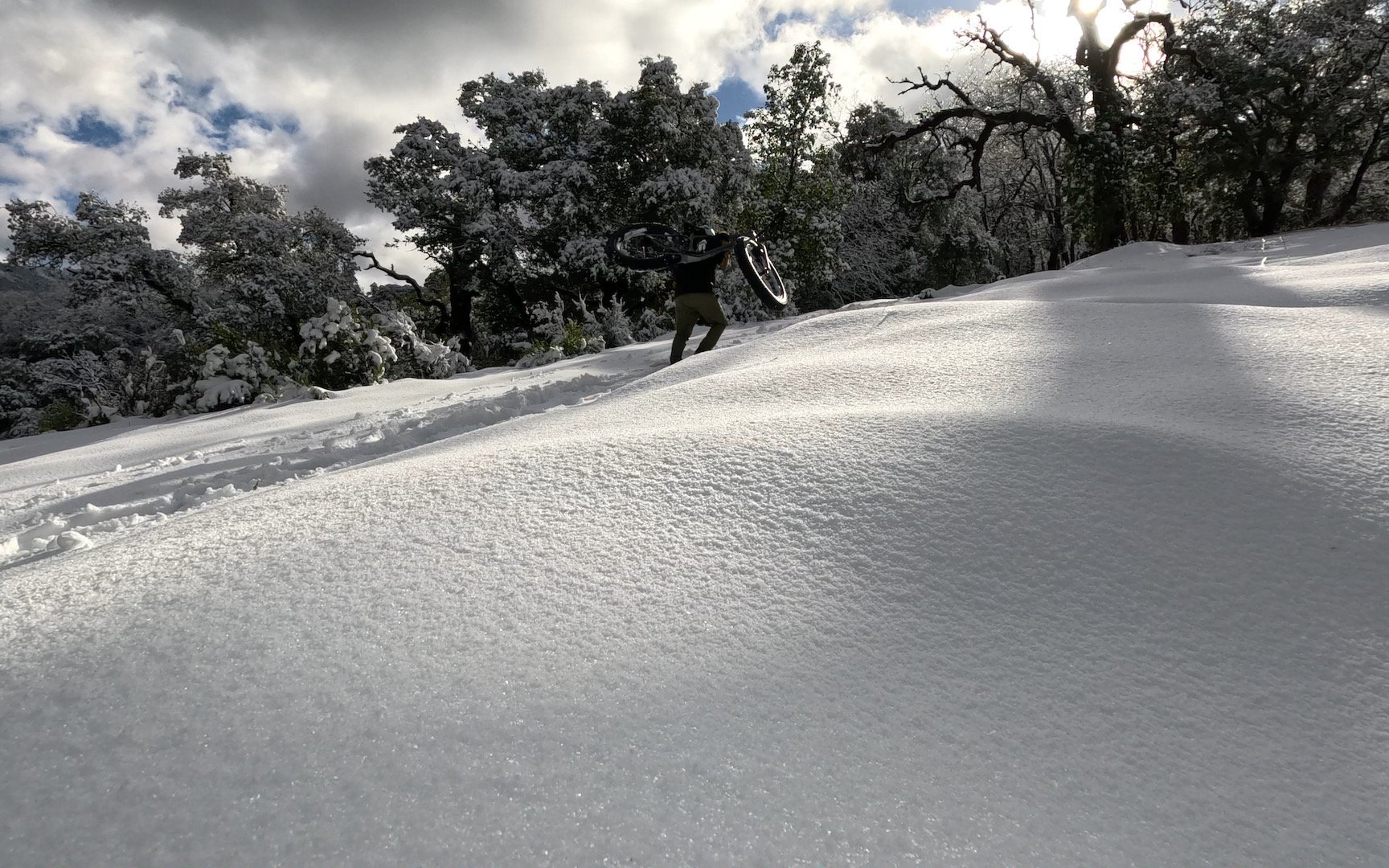
A Sort Of Gear Review
Slowered Expectations
"You're gonna need to get that thing in the snow..."
"Fat bike, huh? Planning on some snow riding?"
"Where are you gonna test that thing? It never snows around here."
When I took delivery of this Fezzari Kings Peak a month ago, I wasn't really contemplating snow riding at all, because, well, it doesn't really snow in this part of California, 20 miles inland from the coast halfway between San Francisco and Santa Barbara. So, naturally, some of the regular local pundits were overt and vocal in their questioning of my sanity. Fair enough. To be fully transparent, I was thinking about Baja, and about places where trails were janky and unpleasant and riding in general was viewed as solid type 3 suffering. I wasn't looking to test this thing to see how much fun I could have. I wanted to explore the conjoined duality of utility and suffering; I wanted to find a way for the misery of riding through thorny, sandy, rocky, untamed arroyos to be lessened enough for me to want to do it more.
But then it went and snowed. A lot.
So, when in Rome, right? In this case, that'd be Rome, Illinois, we're talking about. May as well find out what all this fat biking in snow malarkey is about. I mean, this is why fat bikes exist, right? For riding in snow, right?
As it turns out, "riding" in snow is about as texturally challenging and nuanced as snow itself. And I am here to tell you, in no uncertain terms, that when a foot of diverted Sierra Cement has fallen on the local back 40, it does not matter one bit how wide your tires are. You will mostly be trudging sad little post holes with your rapidly freezing feet and wondering why the fuck anyone ever thought it would be a fun idea to try and ride bikes in this monochromatic hellscape.
None of this is likely to be surprising news to anyone reading this site. You all know way more about snow than I do because many of you experience some amount of the stuff as a regular part of your winters. You probably already know that fat bikes are happier on groomers. You probably also already know that regular bikes with 2.4-2.6" tires can be ridden pretty comfortably on groomers. You probably already saw the photos of Deniz getting sendy in the snow on his Canyon, and even though that wasn't groomed terrain, he seemed to be doing just fine.
So, here I am at the bottom of yet another humiliating learning curve. But I do have some thoughts and observations about fat biking and this here Fezzari, now that it has been "ridden" in the snow. You probably know what I'm about to say, though, because of all the above.
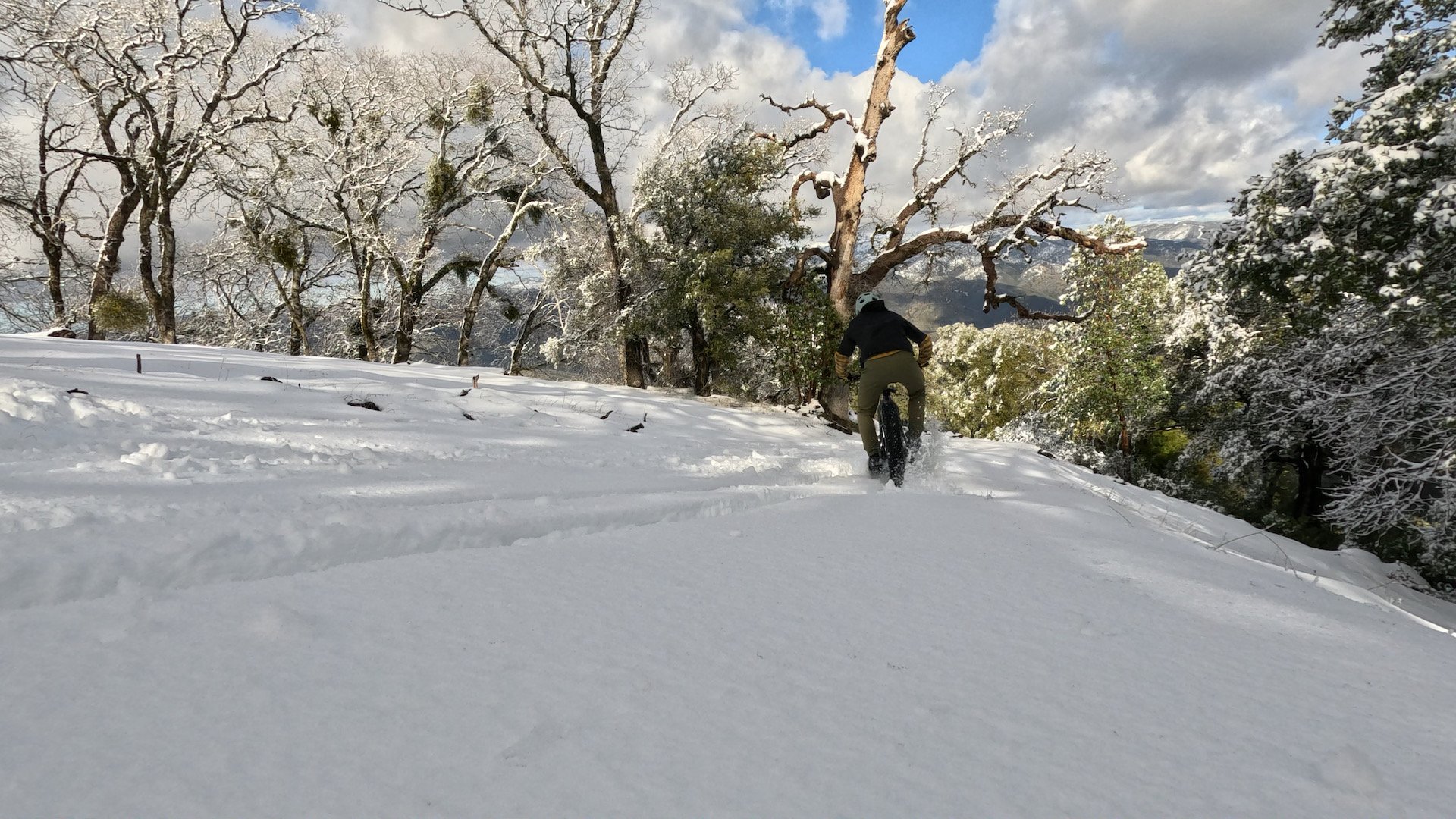
When it comes to riding images of me, this really is my best side...
First, let's talk about snow, just so we can get it out of the way. A few days ago, it dumped about a foot and a half up at Chews Ridge, six miles uphill from my poison oak farm. Every single dipshit living in a 3 hour radius with a lifted Jeep came trundling loudly out of the woodwork, in slow moving, country music blasting convoys, and proceeded to completely trash Tassajara Road, to the weary chagrin of the locals. Many of the locals could fall into the lifted Jeep drivin', country music listenin' spectrum, but they live out here and they need to use that road to go to work and they don't really like destroying that long, potholed dirt road just for the sake of it because the county only grades it once a year. I digress...
Anyway, it snowed a bunch up high, and about four miles uphill from me via a network of trails and backroads, there was/still is a solid 8 inches to a foot of white stuff on the ground, completely untrammeled by anyone. It looks real pretty. It's also just about impossible to ride through. I went up there with the Fezzari and proceeded to get schooled.
In addition to learning that fresh snow is basically a giant trap for wheeled vehicles of all types, it can be a masochistic sort of fun to messing around in. I also found that if the ground sloped downhill steeply enough, I could at times actually move downhill at faster than walking pace without pedaling furiously. This led to interesting fat bike revelation number one:
Anyone who complains about the brakes on a fat bike needs to just shut up. Snow IS a brake. Get going a little too fast? Aim for deeper snow. Also, the likelihood of overheating a brake when it is constantly inundated in frozen water is close enough to zero that it is probably not worth arguing about.
Pointing a fat bike downhill in unpacked snow is actually pretty damn fun, in a drifty slow-mo kinda way. Going uphill in unpacked snow, well, that is not so fun. At first, I thought maybe playing around with tire pressure would help. But after bracketing in 1 psi increments from 3 to 11 psi with no discernible difference in flotation or ability to pedal more than a few feet at a time, I realized that pushing was faster. Interesting fat bike revelation number two:
Just because you have huge tires doesn't mean you can ride everything. Or sometimes even anything. There's a reason that certain cultures have entire vocabularies to describe the consistency and solidity of snow. For the sake of this particular experiment, I woulda way rather been on a nice pair of planks than anything at all with wheels.
Packed snow, like the stuff the Jeepers had driven over but not totally destroyed, was a different beast entirely. Popping out onto a couple miles of the crushed down surface made riding possible again, and allowed me to pedal enough to start sweating through all the layers. Interesting fat bike revelation number three:
Dear lord these things are slow. The mile wide q-factor takes some adjustment to be sure, but because I was riding flats and maybe because I'm a bowlegged goon to begin with, I felt like I could work around that. But those big tires exact a very hefty toll. And, I may have been imagining this, but I could swear that when I dropped the pressures down below 5psi I could feel those humungous tubes flexing and squirming around inside the tire sidewalls, just sucking down the calories. Probably just my imagination, but damn, these bikes can make a boy feel like a weakling.
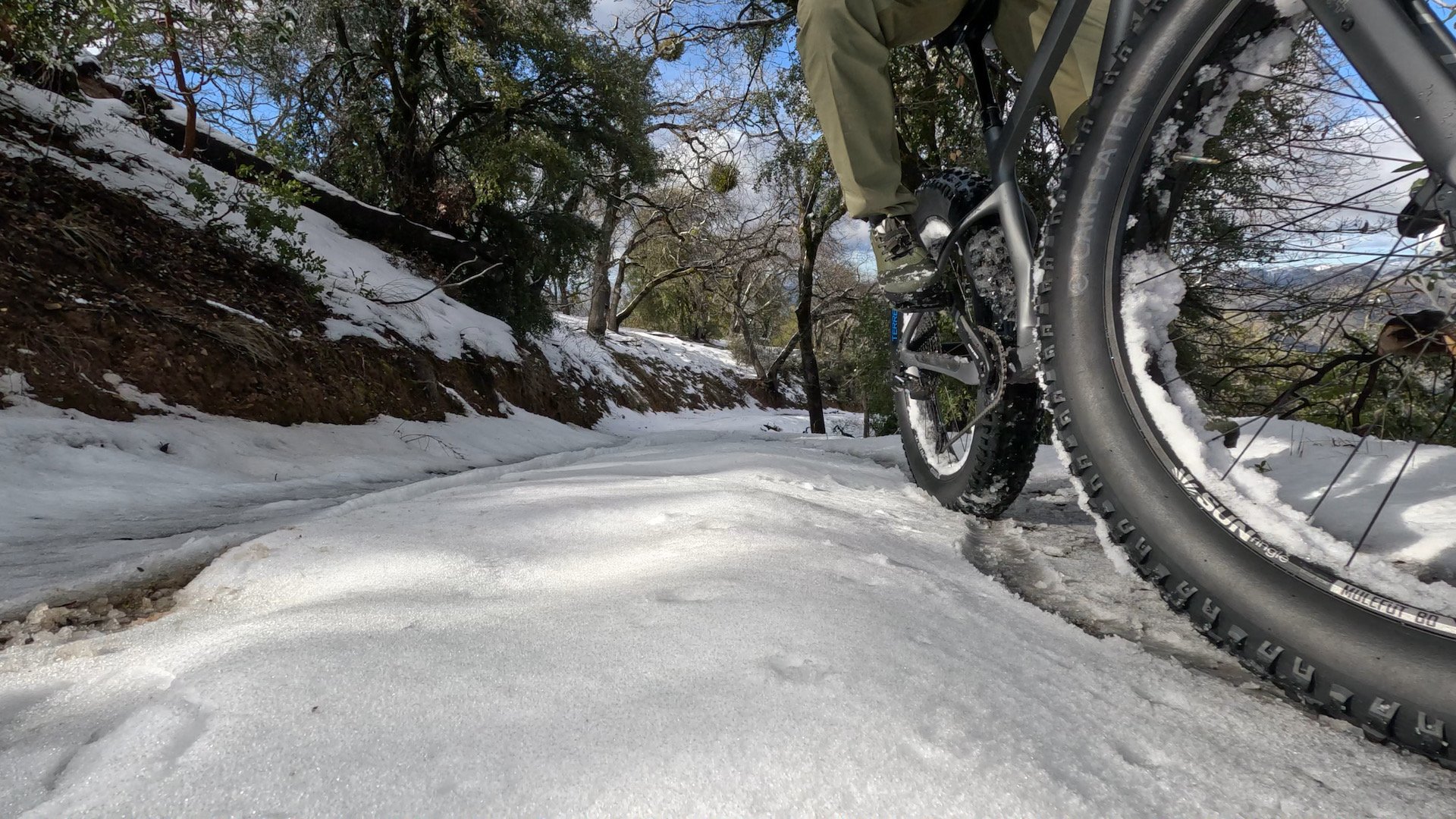
If you listen closely to this photo you can hear me weeping quietly...
Now, about the Fezzari...
I still think it is a screaming value of a bike. But there are some things that are going to need to change.
First up, tubeless conversion. Several people have already told me that I shouldn't have even bothered riding it with tubed tires from the get-go, but that's how it came and that's how this started. Aside from being able to ditch at least 250 grams of rotational mass per wheel, switching to tubeless mitigates a lot of that tube/tire energy loss. And much as I would love to chalk my feelings up to an overactive imagination, there is a whole lot of data out there that speaks to tube/tire friction being a thing with regular little tires pumped up hard. Great big squishy soft tires? Yeah, buh-bye tubes.
I may want to see about ditching another pound or two of dead weight with some aftermarket wheels as well, but then again, that may be gilding the lily. Still thinking about that one.
There's a Manitou Mastodon fork on the way. I want to try it partly because I'm curious about a suspension fork on a fat bike, but also because I'm noticing a very pronounced "high-trail" feel with the steering on the Kings Peak. It is incredibly stable, but it also requires pronounced effort to get it to drop into turns. It's not a bad feeling, per se, but it is an odd one. Experimenting with tire pressure does not change this sensation, so it's not pressure related. There's a Rocky Mountain Blizzard downstairs with the exact same wheels and tires, and a slightly slacker head angle, and it does not exhibit this trait at all. So, my hunch is that it is something to do with trail. Playing around with a fork that has a whole mess of possible axle to crown heights (adjustable between 100-140mm travel) should shed some light on where this is coming from.
And even though I said I was doing okay with the q-factor, I may try to find some cranks that are not quite so wide. There's at least a centimeter to spare on either side of the chainstays that might allow me to shrinkify the distance between the crankarms, depending how much part number crunching I want to endure.
The brakes are staying right where they are. I'm really just leaving them on there in order to set Andrew's teeth on edge.
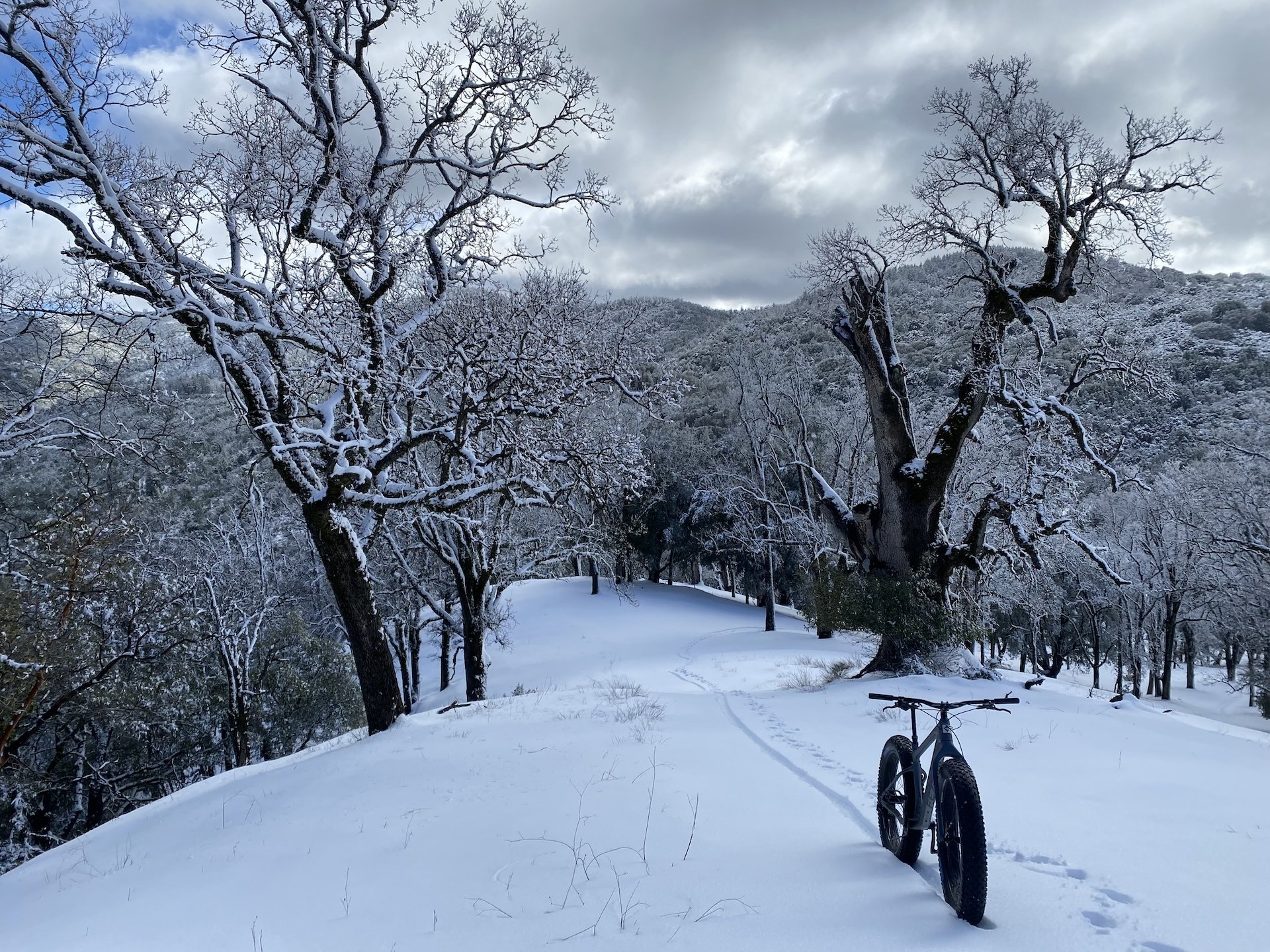
That's about it for now. The snow will probably all be gone by next week, and I will be getting the van and the Fezzari ready for some spring Baja trips. I just need to remember where I stashed my massive King Cage ballena approved bottle holder.
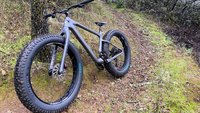
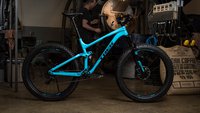
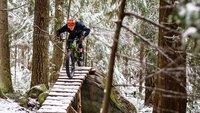
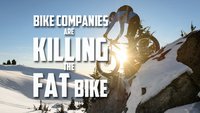
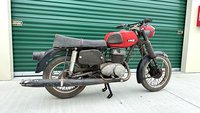
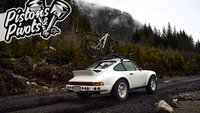

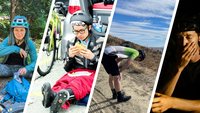
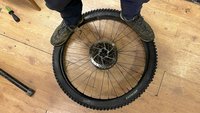
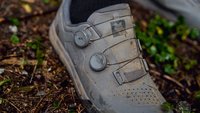
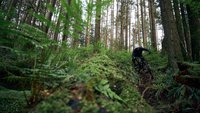
Comments
bishopsmike
1 year, 2 months ago
Honestly, fat biking in several inches fresh snow sucks, especially when it's close to or above freezing. I really hope this isn't your impression of what fatbiking is. Of course it's slow and of course brakes are useless. You really need people (snowshoers, xc skiers, whatever) to pack down the fresh snow first, or you want the fresh snow to condense a bit and then re-freeze. Ripping down a wavy firmly-packed trail at -10*C, touching your back break to coax the rear tire out into a huge left-hand scandi-flick... THAT is what you need to experience.
Reply
taprider
1 year, 2 months ago
"The brakes are staying right where they are I'm really just leaving them on there in order to set Andrew's teeth on edge"
lol
waiting for the reply
Reply
Kyle Doherty
1 year, 2 months ago
As an also green snow biker, I find the hardest part is knowing when it's time to ride. Time since last snow, snow amount, and temperature regimes all interact in a complex way to make or break the experience for me.
Usually I don't have the luxury of picking when I ride. Most of the time my afternoon experiences suck, but every so often the stars align and they don't, and fuck if I know why.
Reply
Jessert
1 year, 2 months ago
As someone both relatively new to fatbiking (this is my 4th winter) and someone who spends as much time grooming winter trails as I do riding them, I feel compelled to chime in here.
First, it sounds like you've passed the rite of initiation to fat biking on snow. A veritable sufferfest with a few moments of salvation. This is normal.
Second, in line with your second revelation, fat biking on snow is extremely conditions dependent. I feel like my grooming informs how and when I ride and vice versa. Generally cold temperatures, low, gradual amounts of snowfall, and tons of tire traffic offer the best results. This isn't always the case but we had a good 2 months with maybe 5cm of snow total from Mid December to mid February and the trails were never better. The feeling of super densely packed firm snow and a great fat tire/rim combo is like nothing else, truly marvelous.
I'm not sure if I have a third specific point so I'll just share a few other thoughts:
- Brakes are important. Ideally you don't ever want to be riding in a situation where you have to control your speed by riding into deep, unpacked snow. I actually found running a 200mm rotor over the stock 160mm my Surly Wednesday came with, to be a marked improvement. Traction on snow is much more finite than on other surfaces so eventually you'll just lockout your tire and start sliding, risking a fall and damaging the trail surface. The larger rotor helps better modulate braking speed and power, resulting in a more confident and fine tuned feeling ride. Metallic pads are also important. Rotors get hot. You crash or go off trail, rotors get snowy, hot rotors melt snow and rotors get real wet.
- It's been said already but lose the tubes. Especially if you're headed to Baja.
- Fatbike forks can be fun. I use a Rockshox bluto and it actually weighs less than the stock surly fork. It's not a good fork in the summer but for smooth winter trail it's a blast and noticeably more comfortable than the rigid option. Just be sure to use winter seals and check air pressure before riding. I've had zero issues down to -35 C
All in all, fat bikes are a bit bizarre and they can vary greatly, even within a category that seems so niche. That said, they are amazing tools for exploration and off season riding fun. I'm fortunate enough to live in a place (The Yukon) that has an abundance of trail suited to winter riding and grooming. Additionally, we've got tons of backcountry snow machine and dogsled trails that get put in over the course of the winter. Mixing machine groomed trail with backcountry packed trail and frozen waterways provides opportunity to explore routes that don't exist in the summer. Good luck with getting the bike dialed in to your desires and have fun!
Reply
Ripbro
1 year, 2 months ago
Setting up a fat bike tube, was by far the most frustrating tubeless experience I’ve ever had. It was on factory taped rims for a 2021 blizzard.
I ended using using a “fatty stripper”, include tubeless in your google search, latex rim strip which made the process painless. Just don’t decide to change tires.
Reply
TristanC
1 year, 2 months ago
I think it's highly dependent on the rims. I have a friend riding Mulefuts and he has a nightmare tubeless setup. I'm on My Other Brother Darryls and they pop right on, easy as pie.
Reply
Spencer Nelson
1 year, 2 months ago
As a data point for anyone else, it could be tires as well. Setting up some super thin/supple Bontrager Barbegazi's tubless on the Mulefuts was one of the most challenging bike-related tasks I've ever done. Yet, a stiffer casing Bontrager Gnarwhal just popped and set the beads no problem.
Reply
bde1024
1 year, 2 months ago
Be ready with an explanation when your spouse or partner sees “fatty strippers” show up on the credit card bill😬
Reply
TristanC
1 year, 2 months ago
"As it turns out, "riding" in snow is about as texturally challenging and nuanced as snow itself."
IMO this applies to most things fat bike. A lot of people look at them and think, "oh, it's a mountain bike with bigger tires," when in reality they're an entirely different animal.
Reply
mrbrett
1 year, 2 months ago
If I’m asked about my fatbike I compare it to XC skiing vs DH skiing. They’re both skiing but very different things.
Mike, wet snow + unfrozen ground = hiking with a bike. I hope Baja is more fun!
Reply
LWK
1 year, 2 months ago
Deniz kind of beat me to it with his comment above, but I was going to say all you need is to add an electric motor and one or more batteries and you'd be back to having a normal MTB! for sure you'd be able to rip up and down all the cement snows just like on a timbersled... /s :^)
Reply
Blofeld
1 year, 2 months ago
The revelations in this article are fantastic. It makes me feel like I’m back on my first fatbike ride, wondering if these Farley seatstays will actually rub a hole through my pants. I hope the conditions persist or your travel schedule permits you to test the suspension and tubeless setup on snow.
My experience (n+1 revelation) has been that 4” tires and snowpack make suspension unnecessary. The trail is a moving average of its summer self once packed and ridden. Roots and holes get covered and filled enough to make the weight addition a poor trade-off. Also, once the thermometer gets to single digits on the F side of the scale, such things don’t work that well, anyway. Sand may be a different beast, so happy testing.
Reply
Kos
1 year, 2 months ago
Welcome to the snow, Mike!
3 psi isn't low enough.
Tubeless helps with the entire experience.
That "other Mike" can help you out in all regards -- except wallet weight -- with some nice carbon wheels that set up tubeless in a snap.
Reply
ZigaK
1 year, 2 months ago
I just finished a tubelless conversion on a 4.6" tire.
Hardest conversion I have done, by far. What finally did the trick of poping the tire on to the rim was a strap. I put a strap with a buckle arround the tire forcing the edges of the tire to the sides. Every now and again I would release a tension in the strap once the tire was inflated enough.
The idea came from here:
https://youtu.be/vZiui5OapQA
Reply
mrbrett
1 year, 2 months ago
I just use the strap + hook part of a ratchet strap (take the buckle off). Put the strap end through the loop on the hook, and pull it as tight as you can around the tire. Hit it with an air compressor and release the end of the strap when it asks you to. Magic.
Reply
XXX_er
1 year, 2 months ago
I been doing that for years to inflate tubeless tires but I use a loop of rope around the bead and twist the loop tight with a screwdriver, never used a compressor and I have always got tires inflated
Reply
DadStillRides
1 year, 2 months ago
Or if you're not willing to go through the effort, just switch to 2.5 super light tubes. I was skeptical when they were recommended to me years ago, but I've very rarely flatted riding pretty hard and saved about ½ lb per wheel. I typically run 5.5 psi on a 4.6 front tire and 7.5 on a 4.0 rear for groomed trail riding. The only downside is a patch won't hold to a tube stretched that much when you do eventually flat.
Reply
Goon
1 year, 2 months ago
I think you nailed the fat bike experience exactly, only thing I changed was my handlebars went wider and more rise.
Reply
Deniz Merdano
1 year, 2 months ago
In my defense, eMTBs just radiate heat and melt all the snow around them. They are also amazing on the slushy snow if terrain is not steep enough to maintain momentum. When it's 60cm fresh and steep enough, this happens and it's glorious.
Freshies
Reply
Hi_Im_Will
1 year, 2 months ago
If you managed to enjoy first tracks in deep snow, you'll love everything else about fat bikes. It doesn't get much slower or more painful than that. Next up try downhill- rumbling past an Enduro bike on a sandy blown out blue trail is special kind of satisfaction :)
Those wheels are excellent, but a b* to set up tubeless. Fill all the little drain holes in the bead seats with something (caulk, silicone, epoxy, bubble gum...) before you try.
Blue-stripe Schwalbe Jumbo Jims set up tubeless roll faster than many trail tires. On tight or sandy trails a fatty on those can be quicker than an XC race bike.
Reply
XXX_er
1 year, 2 months ago
I bought an entry level norco bigfoot 3, it was pretty cheap, so riding on snow is ok but ice is pretty sketck,
so would i buy another one knowing what i know now ?
for sand probably yes but for snow& ice probably not
or course YMMV
Reply
mikesee
1 year, 1 month ago
Yes, tubeless.
I can go years and years of riding in/on snow without ever getting as high as 3psi.
And yes, effort goes up as pressures go down. Riding also beats walking.
Reply
Jeremy Hiebert
1 year ago
> You probably already know that fat bikes are happier on groomers. You probably also already know that regular bikes with 2.4-2.6" tires can be ridden pretty comfortably on groomers.
This. In my experience (in the BC interior), when the snow is packed enough to be really fun on a fat bike, it's packed enough to be really fun on a regular mountain bike. I ride trails all winter on 2.8" Minions, and didn't have to buy an extra bike. 🤷♂️
Reply
Please log in to leave a comment.